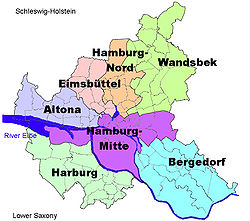Altona, Hamburg
| Altona | ||
|---|---|---|
| Borough of Hamburg | ||

Sol LeWitt, Black Form Dedicated to the Missing Jews, townhall Altona (Altona-Altstadt).
|
||
|
||
| Coordinates: 53°33′0″N 9°56′0″E / 53.55000°N 9.93333°ECoordinates: 53°33′0″N 9°56′0″E / 53.55000°N 9.93333°E | ||
| Country | Germany | |
| State | Hamburg | |
| City | Hamburg | |
| Borough | Altona | |
| Founded | 1535 | |
| Area | ||
| • Total | 77.5 km2 (29.9 sq mi) | |
| Population (31.12.2006) | ||
| • Total | 243,972 | |
| • Density | 3,100/km2 (8,200/sq mi) | |
| Time zone | CET/CEST (UTC+1/+2) | |
| Dialling codes | 040 | |
| Vehicle registration | HH | |
Altona (German pronunciation: [ˈaltona]) is the westernmost urban borough (Bezirk) of the German city state of Hamburg, on the right bank of the Elbe river. From 1640 to 1864 Altona was under the administration of the Danish monarchy. Altona was an independent city until 1937. In 2006 the population was 243,972.
Founded in 1535 as a village of fishermen in then Holstein-Pinneberg. In 1640, Altona came under Danish rule as part of Holstein-Glückstadt, and in 1664 received city rights from Danish King Frederik III, then ruling in personal union as duke of Holstein. Altona was one of the Danish monarchy's most important harbour towns. The railroad from Altona to Kiel, the Hamburg-Altona–Kiel railway (Danish: Christian VIII Østersø Jernbane), was opened in 1844.
Because of the severe restrictions on the number of Jews allowed to live in Hamburg (with the exception of the period of 1811–15,) until 1864, a major Jewish community developed in Altona starting in 1611, when Count Ernest of Schaumburg and Holstein-Pinneberg granted the first permanent residence permits to Ashkenazic Jews. Members did business both in Hamburg and in Altona itself. All that remains after the Nazi Holocaust during World War II are the Jewish cemeteries, but in the 17th, 18th and 19th centuries, the community was a major center of Jewish life and scholarship. The Holstein-Pinneberg and later Danish Holstein had lower taxes and placed fewer civil impositions on their Jewish community than did the government of Hamburg.
...
Wikipedia



